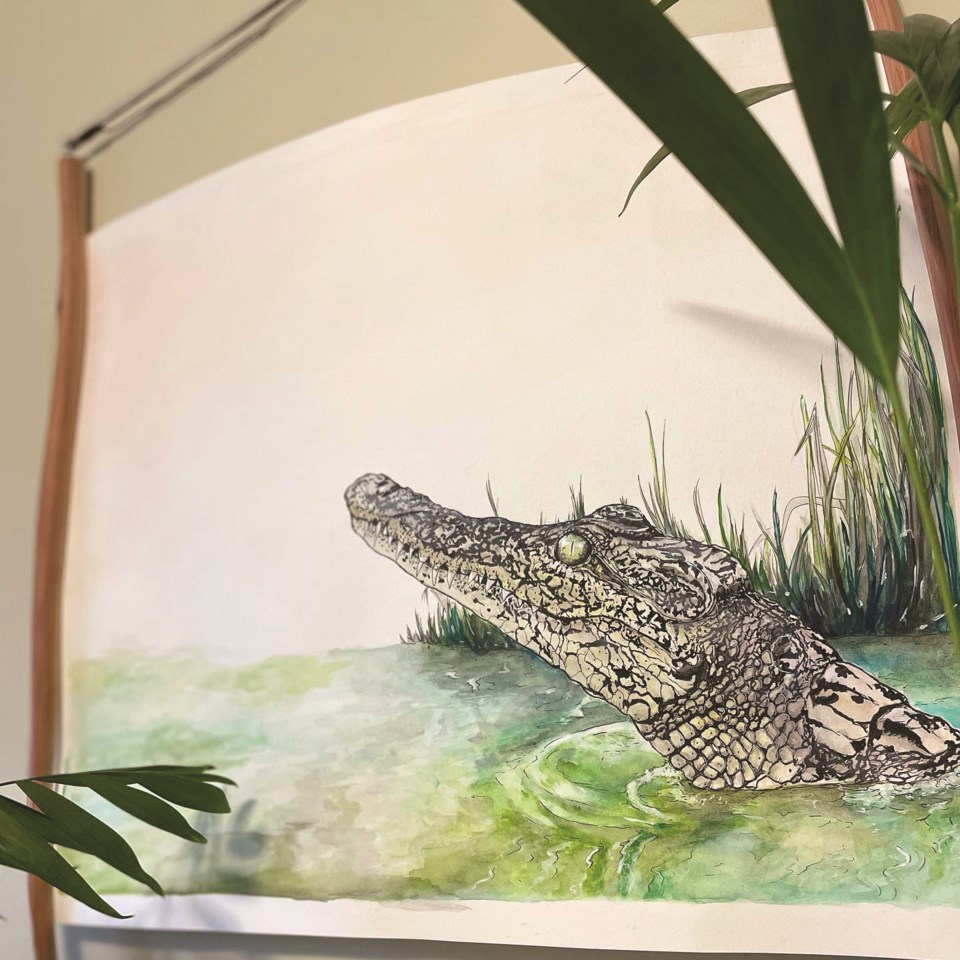Greg Funk’s Catzilla, one of two feline-themed paintings he has featured in Arts Whistler’s latest exhibit, depicts a giant cat clutching two measly humans while crushing a family sedan under its paw.
“That’s kind of what cats would do if they could, I think,” says the 44-year-old Whistler artist. “You know how they can be moody and unpredictable at times. That’s all that is. It’s kind of fun, I thought.”
For the uninitiated, a three-storey-tall cat on a deadly rampage might seem a departure from the serene landscapes and lifelike wildlife paintings you are likely to find in galleries across the Sea to Sky. But dig a little deeper, and you’ll discover an art scene as wildly diverse as the cosmopolitan population that is drawn here.
That is clear from the multitude of works on offer in We Heart Local Art, a six-week exhibition at the Maury Young Arts Centre that features pieces from 24 Sea to Sky artists, working in a variety of styles and mediums.
“There is so much deep talent in Whistler,” says Arts Whistler executive director Mo Douglas. “The art scene is getting stronger all the time even in spite of the pandemic, and with that, what we’re seeing is artists making choices to be more diverse, to take more risks, to work more in abstracts or multimedia. We’re starting to see them explore other themes, whether it’s social issues, anthropological … [or] art that’s fun and whimsical.”
There’s the aforementioned Funk, whose work tends to draw on everything from B-movie culture to the surrealism of Salvador Dali and the highly graphic, psychedelic work of Juxtapoz founder Robert Williams.
“There is some lowbrow influence there, pop art influence, surrealism, stuff like that,” says Funk. “I know Robert Williams referred to his art as ‘living-room destroyers.’ I like that term but I get that everybody might not want to have one of my pieces hanging on their wall. Some people love it. Maybe it’s a love-hate thing.”
Contrast that with Aurora Moore, the Pemberton artist working mostly in pen and watercolour whose work sits at the nexus of science and art and is directly inspired by the richly detailed botanical and entomological drawings by frontier explorers and researchers of old.
“It’s such a draw for me, that educational side of it and the beauty,” she says, highlighting the work of naturalists and explorers like Henry Bates, Howard Carter and Maria Merian, who combined the keen observation of a researcher with the eye for beauty of an artist.
“I love showing that to my kids. Going out and getting excited over, like, a piece of lichen or a mushroom,” she adds. “It’s just neat. But also, those old explorers and old artists—I work mostly from photographs—and I just think it’s so impressive that they would have been working just from being out in the field and looking at these animals and really bringing so much detail to that. Being able to have that much observation is so impressive.”
Even the exhibiting artists who tend to stick to the kind of subject matter the Sea to Sky is known for frequently do so in their own distinct style. Long-time Whistler artist Marcelle Armatage, for instance, focuses on abstract landscapes, subverting natural colour schemes and forms in a way that lends the viewer a deeper emotional picture of the terrain.
“There’s almost an abstract quality but still that really strong sense of texture in what you’re seeing in the landscape, as if your brain completely reinterpreted the colours,” Douglas says.
The exhibit also features a fair deal of technological aspects, with numerous artists combining traditional mediums with contemporary ones, like Squamish’s Stacey Bodnaruk, who uses an approach she calls “artography” that layers and fuses multiple photos, including ground and aerial photography, into one perspective-defying image.
According to Douglas, it’s at least a partial response to the pandemic.
“Necessity is the motherhood of invention and I think the downtime potentially had in the beginning spurred a lot of creativity. It’s like, ‘What am I going to do with this energy?’” she says.
We Heart Local Art came together because Arts Whistler had a hole to fill in the calendar after moving the popular Anonymous Art Show to the spring, and after a tough year on the sector as a whole, it’s another way for artists to get their work out and make some money while they’re at it.
The exhibit is on now through Oct. 31 and the works are for sale now and for four weeks after it closes, viewable online through a 3D virtual gallery. Learn more at artswhistler.com/event/weheartlocalart.





-copy.jpg;w=120;h=80;mode=crop)